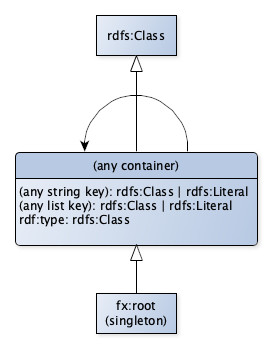Facade-X
Facade-X is a simplistic meta-model used by SPARQL Anything transformers to generate RDF data from diverse data sources. Intuitively, Facade-X uses a subset of RDF as a general approach to represent the source content as-it-is but in RDF. The model combines two types of elements: containers and literals. While literals are used to represent primitive data types (i.e. strings, integers etc.), containers represent an information unit of a data source. This could be an array or an object in JSON format, a Row in CSV, or an element in XML. Therefore, the interpretation of what a container is on a format base. Please refer to the supported format description for more details on what is a container. Facade-X always has a single root container. Container members are a combination of key-value pairs, where keys are either RDF properties or container membership properties. Instead, values can be either RDF literals or other containers. Containers may have a type.
The following figure illustrates the resulting Facade-X as an entity-relation diagram.

Given a resource, the transformers generate an RDF Dataset (i.e. a collection of named graphs) representing the transformation of the resource according to the Facade-X model. In particular, each named graph: 1. is the transformation of a data source of the input resource; and, 2. complies with the Facade-X model. The default graph of the resulting RDF Dataset is the union of all the named graphs.
IRI conventions
As a general meta-model for representing diverse data sources in RDF, Facade-X does not prescribe any IRI convention. However, SPARQL Anything implements convenient conventions for homogenising IRIs generated.
Default configuration
By default, SPARQL Anything uses blank nodes to represent containers.
The URI of the RDF properties is the result of the concatenation of the default namespace for data http://sparql.xyz/facade-x/data/ and a string.
The string derives from a field name (in case of a data source in JSON format), a tag attribute (in case of a data source in XML format) etc.
The URI of the RDF classes is the result of the concatenation of the default namespace for data http://sparql.xyz/facade-x/data/ and a string.
The string derives from a tag name (in case of a data source in XML format), an element type (in case of a data source in Markdown format).
The URI of the named graph is always equal to the uri-root-container.
The URI of the root container (indicated as uri-root-container) is as follows: base + / + identifier-of-the-data-source.
Where base can be:
- the value of the option root
- the URI of the location (in the case of location argument set)
- or, 'http://sparql.xyz/facade-x/data/' + md5Hex(content) (in the case of content argument set)
- or 'http://sparql.xyz/facade-x/data/' + md5Hex(command) (in the case of command argument set)
Note that, in case that the resource has a single data source the uri-root-container resolves to the value of the root option.
The URI of the default named graph is urn:x-arq:DefaultGraph.
Blank nodes = false
When the option blank-nodes is set as false, containers are represented as URI resources.
In this case, the URI of the container is uri-root-container + \ + path-to-the-container-in-the-data-source.
The notion of path is format-specific (for example, is the JSONPath leading to the object for the JSON format or the row number for the CSV format).
Terminology
- Resource: We consider a resource anything accessible from a URL (e.g. a spreadsheet file) and distinguish it from its content, that we name data source (e.g. a sheet of a spreadsheet).
- Data source: The content of a data source.
- Location: The URL of a data source.